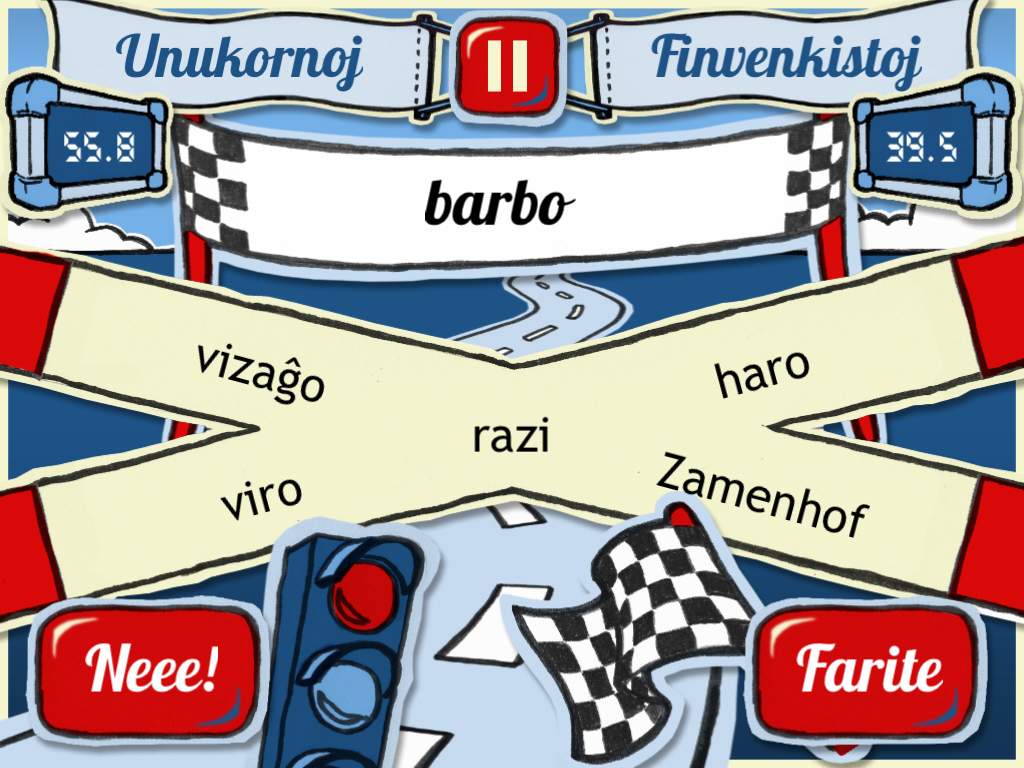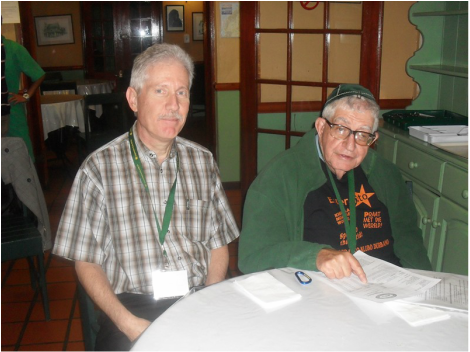BONVENONKara leganto En tiu ĉi numero legu pri lokaj renkontiĝoj kaj malkovru kelkajn interesajn informojn. Feliĉan festotempon kaj prosperan novan jaron! | WELCOMEDear reader In this edition, read about local meetings and discover some interesting information. Happy festive season and a prosperous new year! |
Lokaj renkontiĝojKaburba renkontiĝo La 30an de Oktobro rekontiĝis 10 Kaburbaj esperantistoj kaj unu el Johanesburgo. La renkontiĝo okazis en kafejo en la kvartalo Constantia, malantaŭ la fama Tablo-monto. Inter la partoprenintoj preskaŭ duonon povis paroli Esperanton. Sean Ravenscroft kaj Emile Malanda, kune kun la gasto Johan Kohler estas sufiĉe spertaj Esperantistoj. Richard Cooke, kiu unua foje renkontis Esperantistojn estas memlerninto kaj bone parolis Esperanton. Fabian Kunnen, eksterlandano, ĝojis finfine trovi aliajn Esperantistojn junajn. La renkontiĝo organiziĝis pere de Meetup.com. Chelsea Manning antaŭnelonge aliĝis la Meetup-grupon, sed, Anne Taylor kaj Jonathan Lee Ching jam delonge estas membroj. Jonathan antaŭnelonge fariĝis la organizanto de Kaburbaj renkontiĝoj pere de Meetup. Bernadette Dimbi jam de 2013 estas membro de la Kaburba Esperanto-Klubo organizita de Emile Malanda, kaj Henoc kaj Justin Le Bon estis (laŭ scio de la verkisto) interesuloj pri Esperanto. | Local meetingsCape Town meeting On 30 October 10 Capetonian esperants and one from Johannesburg got torgether. The meeting took place in a cafe in the suburb Constantia, behind the famous Table Mountain. Among the participants about half could speak Esperanto. Sean Ravenscroft and Emile Malanda, together with the guest Johan Kohler are quite experienced Esperantists. Richard Cooke, who met Esperantists for the first time is self-taught and spoke Esperanto well. Fabian Kunnen, a foreigner, was happy to finally find other young Esperantists. The meeting was organised throuĝ Meetup.com. Chelsea Manning recently joined the Meetup group, but Anne Taylor and Jonathan Lee Ching have been members for a long time. Recently Jonathan became the organiser of Cape Town meetings through Meetup. Bernadette Dimbi has been a member of the Cape Town Esperanto Club, organised by Emile Malanda, since 2013 and Henoc and Justin Le Bon are (as far as the author is aware) newly interested in Esperanto. |
| Renkontiĝo Johanesburga kun Belga esperantisto Andreo Belga Esperantisto Andre de Marque kaj sia ne-esperantista edzino Anne-Marie venis al Sudafriko por kelksemajna vojaĝo. Ili uzis Pasportan Servon por aranĝi tranokton ĉe la verkisto, kaj ankaŭ Servas kaj la proprajn kontaktojn dum la vojaĝo. Tiel ili malpliigis restadon en hoteloj. En Johanesburg malgranda grupo renkontis Andre ĉe tre agrabla restoracio "The Living Room" en la kvartalo Maboneng. Pro la programo de la vizitanto, la kunveno devis okazi Ĵaŭdon, kaj eble pro tio ne pli da homoj povis partopreni. La loko estas vidinda, speciale la unuan Ĵaŭdon de ĉiu monato. Tiun tagon la loko estas elirpunkto por malferma vespero de apudaj muzeoj kaj galerioj. Oni disponeblas mapon kiu montras ĉiujn lokojn kiuj partoprenas tiun ĉi aranĝon, nomata "First Thursdays" (Unuaj Ĵaŭdoj) La babilado inter la partoprenintoj estis vigla kaj interesa. Ĉiuj multe ĝuis la vesperon. | Johannesburg meeting with Belgian esperantist Andre Belgian Esperantist Andre de Marque and his non-esperanto-speaking wife, Anne-Marie, came to South Africa for trip of several weeks. They used Pasporta Servo (Passport Service, a couch-surfing network for Esperanto speakers) to arrange to stay over at the author's place, and also Servas and their own contacts during the trip. In this way they reduced hotel stays. In Johannesburg a small group met Andre at a very nice restaurant, "The Living Room", in the Maboneng precinct. Owing to the visitor's schedule, the meeting had to take place on a Thursday, and maybe for this reason not many people were able to take part. The venue is worth seeing, especially on the first Thursday of each month. On that day the venue is the departure point for an open night of the nearby museums and galleries. A map is made available which shows all the venues participating in this arrangement called "First Thursdays". The conversation among the participants was lively and interesting. Everyone thoroughly enjoyed the evening. |
Interesaj LigilojĈi tiu estas la unua de serio de artikoletoj kie kolektiĝs ligilojn pri Esperantujo, inklusivonte: Kulturo, Lingvo, Muziko Geografio. Kolektis kaj koktelis Ilze. Esperantujo Historio Grava ideo pri Esperanto* estas ke, se ĉiuj homoj parolas saman duan lingvon, oni povas malpliigi la riskoj de lingva kaj kultura superrego (vidu Patricia Ryan (angle), Lingvoj gravas*, Lingvaj Rajtoj*). Esperanto unue publikiĝis je 1887. Ĝi estas unu el pluraj konstruitaj_lingvoj* kreitaj kun diversaj celoj. Ĝi fartis pli bone ol aliaj – parte ĉar D-ro LL Zamenhof*, kiu kreis ĝin, komprenis ke uzo de lingvo per realaj homoj nepre signifos kulturo. Li tradukis gravaj verkoj* kaj verkis poezio (ekz.-o*) por elprovi la lingvon, kaj lasis la homa uzo gvidi ĝian evolucion. La lingvo altiris milionojn. Parolintaj persekutiĝis per Stalin kaj Hitler – la hostorio rakontiĝas en la libro La Danĝera Lingvo* de Ulrich Lins. Interesiĝo kreskis kaj malpliiĝis je la 1970-aj jaroj, do reviviĝis kun la kresko de la interreto. David K Jordan (emerita profesoro de antropologio) ofertas informplena TTTejo. | Interesting linksThis is the first of a series of short articles collecting Esperantoland links, with Culture, Language, and Geography and Music to come. Compiled by Ilze . Esperantoland History A major idea behind Esperanto is that if everyone shares a second language, the risks of linguistic and cultural domination can be lessened (Patricia Ryan talk, UEA to UN, Global Harmony). Esperanto was first published in 1887. It is one of many constructed languages created with varied aims. It fared better than others – partly because Dr LL Zamenhof, who created it, understood that real people using a language would necessarily mean culture. He translated major works and wrote poetry to test the language, and let people’s use of it guide its evolution. The language attracted millions. Speakers were persecuted by Stalin and Hitler – the story is told in Ulrich Lins’ book The Dangerous Language. Interest peaked and faded in the 1970s, then revived with the rise of the internet. David K Jordan (emeritus professor of anthropology) offers a very informative website. |

















 RSS Feed
RSS Feed